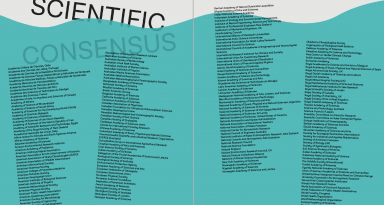Svante August Arrhenius was a Swedish scientist who received the Nobel Prize for Chemistry in 1903. Arrhenius was the first to use basic principles of physical chemistry to estimate the extent to which increases in atmospheric carbon dioxide are responsible for the Earth’s increasing surface temperature.
A great deal has been written on the influence of the absorption of the atmosphere upon the climate. Tyndall in particular has pointed out the enormous importance of this question. To him it was chiefly the diurnal and annual variation of the temperature that were lessened by this circumstance. Another side of the question, that has long attracted the attention of physicists, is this: Is the mean temperature of the ground in any way influenced by the presence of heat-absorbing gases in the atmosphere? Fourier maintained that the atmosphere acts like the glass of a hot-house, because it lets through the light rays of the sun but retains the dark rays from the ground. This idea was elaborated by Pouillet; and Langley was by some of his researches led to the view, that “the temperature of the earth under direct sunshine, even though our atmosphere were present as now, would probably fall to -200°C., if that atmosphere did not possess the quality of selective absorption”. This view, which was founded on too wide a use of Newton’s law of cooling, must be abandoned, as Langley himself in a later memoir showed that the full moon, which certainly does not possess any sensible heat-absorbing atmosphere, has a “mean effective temperature” of about 45°C.
The air retains heat (light or dark) in two different ways. On the one hand, the heat suffers a selective diffusion on its passage through the air; on the other hand, some of the atmospheric gases absorb considerable quantities of heat. These two actions are very different. ...
The selective absorption of the atmosphere is, according to the researches of Tyndall, Lecher and Pernter, Röntgen, Heine, Langley, Ångström, Paschen, and others, of a wholly different kind. It is not exerted by the chief mass of the air, but in a high degree by aqueous vapour and carbonic acid, which are present in the air in small quantities. Further, this absorption is not continuous over the whole spectrum, but nearly insensible in the light part of it, and chiefly limited to the long-waved part, where it manifests itself in very well-defined absorption-bands, which fall off rapidly on both sides. The influence of this absorption is comparatively small on the heat from the sun, but must be of great importance in the transmission of rays from the earth. Tyndall held the opinion that the water-vapour has the greatest influence, whilst other authors, for instance Lecher and Pernter, are inclined to think that the carbonic acid plays the more important part. The researches of Paschen show that these gases are both very effective, so that probably sometimes the one, sometimes the other, may have the greater effect according to the circumstances.
...
We may now inquire how great must the variation of the carbonic acid in the atmosphere be to cause a given change of the temperature. The answer may be found by interpolation in Table VII [not included here]. To facilitate such an inquiry, we may make a simple observation. If the quantity of carbonic acid decreases from 1 to 0.67, the fall of temperature is nearly the same as the increase of temperature if this quantity augments to 1.5. And to get a new increase of this order of magnitude (3°.4), it will be necessary to alter the quantity of carbonic acid till it reaches a value nearly midway between 2 and 2.5. Thus if the quantity of carbonic acid increases in geometric progression, the augmentation of the temperature will increase nearly in arithmetic progression. This rule – which naturally holds good only in the part investigated – will be useful for the following summary estimations.
...
I should certainly not have undertaken these tedious calculations if an extraordinary interest had not been connected with them. In the Physical Society of Stockholm there have been occasionally very lively discussions on the probable causes of the Ice Age; and these discussions have, in my opinion, led to the conclusion that there exists as yet no satisfactory hypothesis that could explain how the climatic conditions for an ice age could be realised in so short a time as that which has elapsed from the days of the glacial epoch. The common view hitherto has been that the earth has cooled in the lapse of time; and if one did not know that the reverse has been the case, one would certainly assert that this cooling must go on continuously. Conversations with my friend and colleague Professor Högbom, together with the discussions above referred to, led me to make a preliminary estimate of the probable effect of a variation of the atmospheric carbonic acid on the belief that one might in this way probably find an explanation for temperature variations of 5°-10°C., I worked out the calculation more in detail, and lay it now before the public and the critics.
From geological researches the fact is well established that in Tertiary times there existed a vegetation and an animal life in the temperate and arctic zones that must have been conditioned by a much higher temperature than the present in the same regions. The temperature in the arctic zones appears to have exceeded the present temperature by about 8 or 9 degrees. To this genial time the ice age succeeded, and this was one or more times interrupted by interglacial periods with a climate of about the same character as the present, sometimes even milder. When the ice age had its greatest extent, the countries that now enjoy the highest civilisation were covered with ice. This was the case with Ireland, Britain (except a small part in the south), Holland, Denmark, Sweden and Norway, Russia (to Kiev, Orel, and Nijni-Novgorod), Germany and Austria (to the Harz, Erz-Gebirge, Dresden, and Cracow). At the same time an ice-cap from the Alps covered Switzerland, parts of France, Bavaria south of the Danube, the Tyrol, Styria, and other Austrian countries, and descended into the northern part of Italy. Simultaneously, too, North America was covered with ice on the west coast to the 47th parallel, on the east coast to the 40th, and in the central part to the 37th (confluence of the Mississippi and Ohio rivers). In the most different parts of the world, too, we have found traces of a great ice age, as in the Caucasus, Asia Minor, Syria, the Himalayas, India, Thian Shan, Altai, Atlas, on Mount Kenia and Kilimandjaro (both very near to the equator), in South Africa, Australia, New Zealand, Kerguelen, Falkland Islands, Patagonia and other parts of South America. The geologists in general are inclined to think that these glaciations were simultaneous on the whole earth; and this most natural view would probably have been generally accepted, if the theory of Croll, which demands a genial age on the Southern Hemisphere at the same time as an ice age on the Northern and vice versa, had not influenced opinion. By measurements of the displacement of the snow-line we arrive at the result, – and this is very concordant for different places – that the temperature at that time must have been 4°-5°C. lower than at present. The last glaciation must have taken place in rather recent times, geologically speaking, so that the human race certainly had appeared at that period. Certain American geologists hold the opinion that since the close of the ice age only some 7000 to 10,000 years have elapsed, but this most probably is greatly underestimated.
One may now ask, How much must the carbonic acid vary according to our figures, in order that the temperature should attain the same values as in the Tertiary and Ice ages respectively? A simple calculation shows that the temperature in the arctic regions would rise about 8° to 9°C., if the carbonic acid increased to 2.5 or 3 times its present value. In order to get the temperature of the ice age between the 40th and 50th parallels, the carbonic acid in the air should sink to 0.62-0.55 of its present value (lowering of temperature 4°-5°C.). The demands of the geologists, that at the genial epochs the climate should be more uniform than now, accords very well with our theory. The geographical annual and diurnal ranges of temperature would be partly smoothed away, if the quantity of carbonic acid was augmented. The reverse would be the case (at least to a latitude of 50 from the equator), if the carbonic acid diminished in amount. But in both these cases I incline to think that the secondary action due to the regress or the progress of the snow-covering would play the most important role. The theory demands also that, roughly speaking, the whole earth should have undergone about the same variations of temperature, so that according to it genial or glacial epochs must have occurred simultaneously on the whole earth. Because of the greater nebulosity of the Southern hemisphere, the variations must there have been a little less (about 15 per cent) than in the Northern hemisphere. The ocean currents, too, must there, as in the present time, have effaced the differences in temperature at different latitudes to a greater extent than in the Northern hemisphere. This effect also results from the greater nebulosity in the arctic zones than in the neighbourhood of the equator.
< Talk radio | Around the web >





































